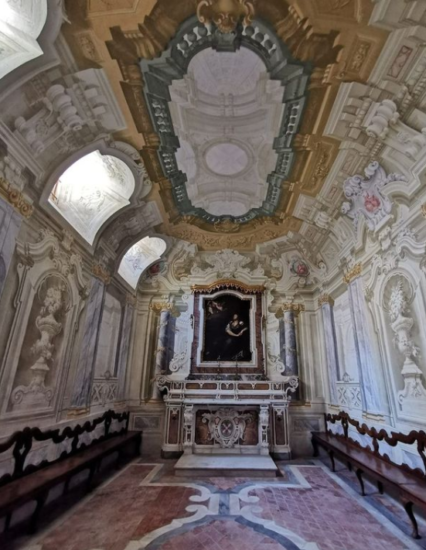Certosa di San Martino
For the construction of the Certosa di San Martino, founded in 1325, the Sienese architect and sculptor Tino di Camaino was called. The grandiose gothic undergrounds remain of the original structure, an important engineering work.Over the course of five centuries, the Certosa underwent constant renovations, in 1581, a grandiose expansion project was started, entrusted to the architect Giovanni Antonio Dosio, destined to transform its severe Gothic appearance into the current precious and refined Baroque style.
The growing number of monks forced a radical restructuring of the Great Cloister: new cells were built and the entire water system was revised. The promoter of this new and spectacular appearance of the Certosa di San Martino is the prior Severo Turboli, in office from the last twenty years of the sixteenth century to 1607.
The works started under the direction of Dosio, are continued by Giovan Giacomo di Conforto, who will build the monumental cloister cistern. On September 6, 1623, the collaboration with the construction site of San Martino of the architect Cosimo Fanzago begins, which, among various events, will last until 1656.



Fanzago will connote every place of the monastery with the unmistakable sign of the overbearing personality. Fanzago’s work is characterized by an extraordinary decorative activity, transforming the traditional geometric decorations into apparatuses composed of foliage, fruits, stylized scrolls, to which the chromatic and volumetric effects give a character of exceptional realism and sensuality.
Around 1723, the royal engineer and architect of the Charterhouse Andrea Canale was replaced by his son Nicola Tagliacozzi Canale, better known as an engraver and creator of scenic equipment. Commonly defined as architect-scenographer, Nicola occupies a place of absolute importance in the area of refined eighteenth-century culture. Especially for what concerns the experimentation of taste in terms of decoration and integration between ornamentation and architectural structure. Participates in that dense and fervent artistic expression that goes by the name of Rococo and which manifests itself with a perfect synthesis between painting, sculpture and architecture.
The complex suffered damage during the 1799 revolution and is occupied by the French. The king orders the suppression of the Carthusians suspected of republican sympathies, but in the end he agrees to reinstatement. Revoked the suppression, the monks returned to San Martino in 1804. When the last monks left the Certosa, in 1812 the complex was used by the military as the House of War Invalids, until 1831, when it was abandoned again for urgent restoration.



In 1836 a small group of monks returned to settle in San Martino and then finally succeeded. With the suppression of religious orders and becoming state property, the Certosa was destined in 1866 as a museum by the will of Giuseppe Fiorelli, annexed to the National Museum as a detached section and opened to the public in 1867.
Located at the entrance to the Certosa, the monumental courtyard is a very large space where you can admire the spur of the stellar shape of Castel Sant’Elmo and the facade of the Church. In the large courtyard opens the pronaos of access to the church, a sort of ‘museum’ of Neapolitan painting and sculpture from the seventeenth to the eighteenth century.
The chapels, on the sides of the nave, are covered with precious marble inlays, particularly refined in the chapel dedicated to San Bruno, founder of the Carthusian Order, by Cosimo Fanzago. The basements constitute the evocative and imposing rooms of the fourteenth-century foundations of the Certosa, a building that began in May 1325 at the behest of Charles, Duke of Calabria. A powerful and elegant work of engineering, with a succession of pillars and ogival vaults supporting the entire Carthusian structure, the marble works of the Sculpture and Epigraph Section are exhibited in the long corridors and open spaces.



A collection that was formed through purchases, bequests, donations, transfers and deposits between the end of the nineteenth century and the first decades of the twentieth century. In the old completely reconstructed rooms, occupied since the end of the 19th century by the royal boats deposited by the Regia Marina, the naval section has its strong point, as well as in the historical importance of the testimonies it exhibits, precisely in the particular aspect of the two great environments that compose it. These, while fully respecting the most advanced museum technologies, directly evoke the environments of an ancient arsenal.
The Cabinet of Drawings and Prints of the Museum of San Martino, with its approximately sixteen thousand sheets, is placed next to the collection of the Capodimonte Museum in terms of quality and quantity. The graphic heritage, coming from various collections, forms a collection centered above all on some strands.
The entrance hall connects the Cloister of the Procurators with the gardens of the Certosa, taking its name from the carriages that are exhibited there. The oldest, the Carriage of the city, was made of gilded wood and enriched with paintings and precious fabrics between the end of the seventeenth and the beginning of the eighteenth century, by order of the Court of San Lorenzo, to transport the elect of the city; it was used for official ceremonies, such as the Corpus Domini processions, and was released for the last time in 1861. The place offers the most spectacular views of the bay of Naples you can possibly find anywhere so be sure to take your camera with you. MORE




